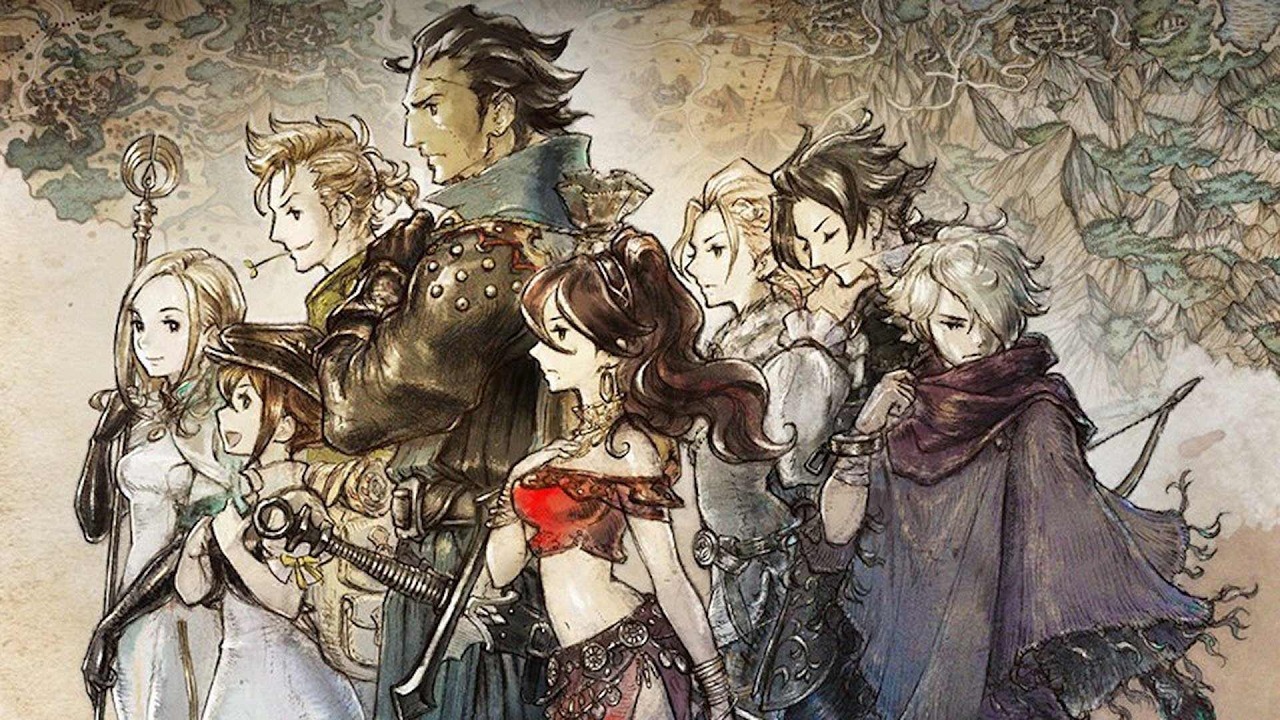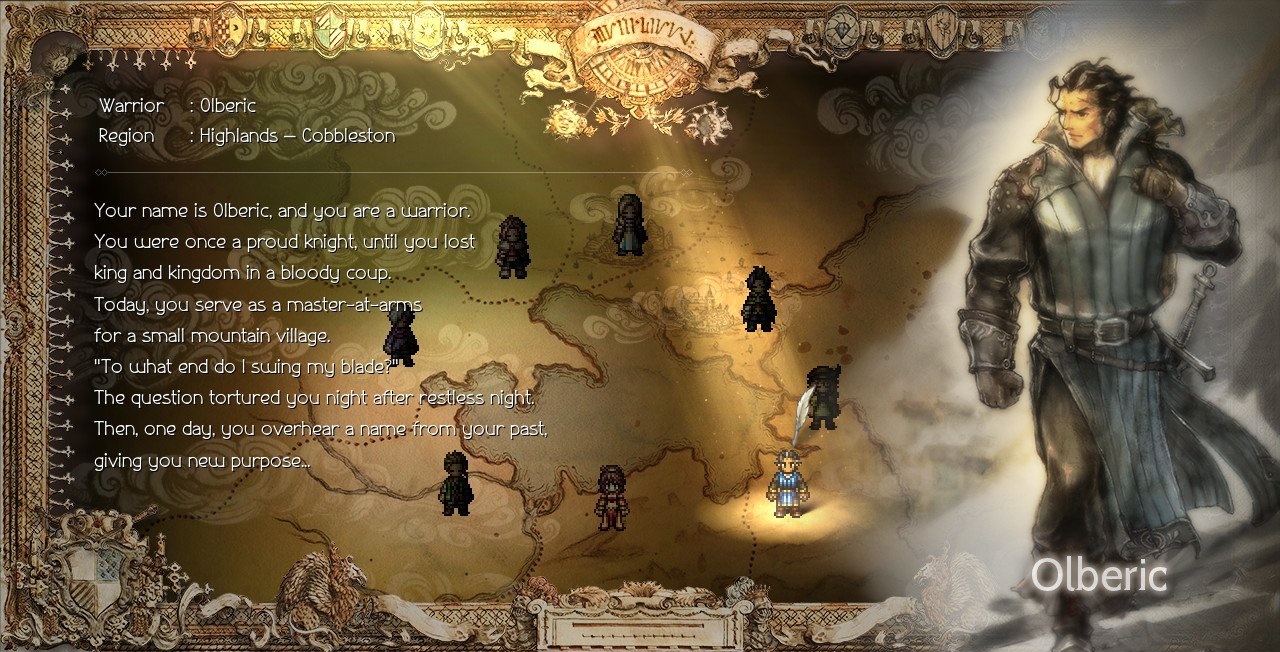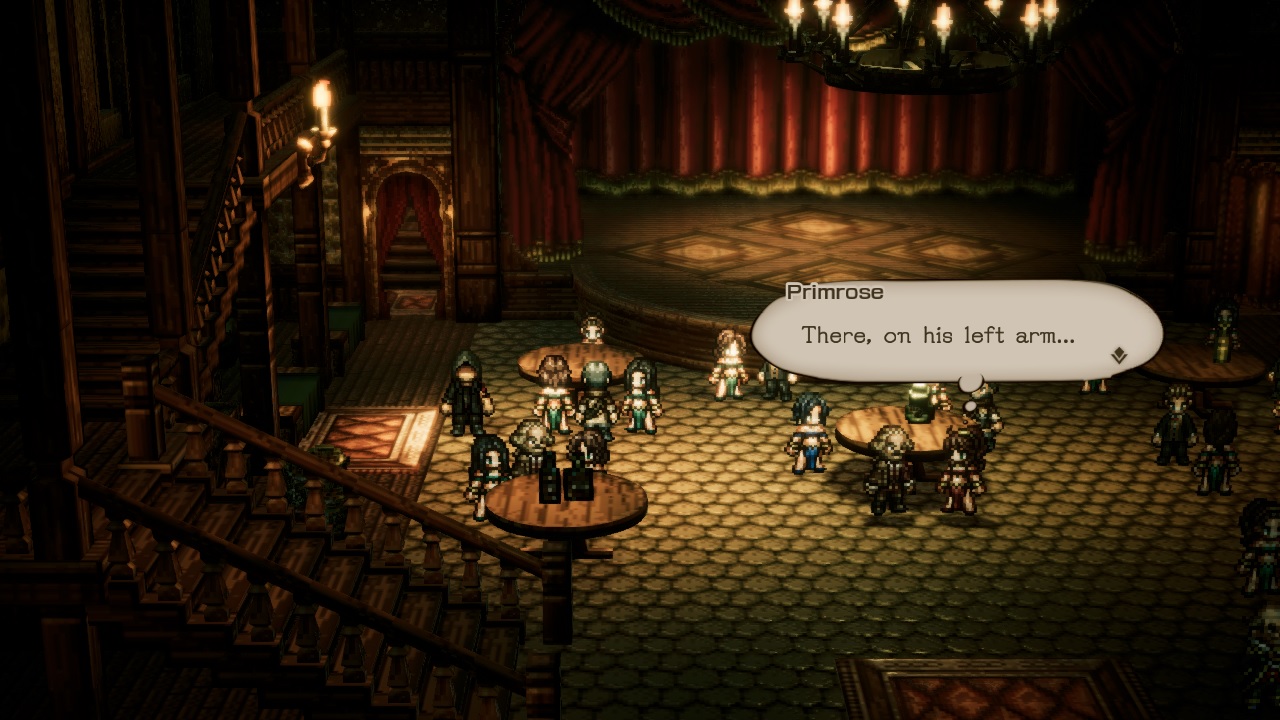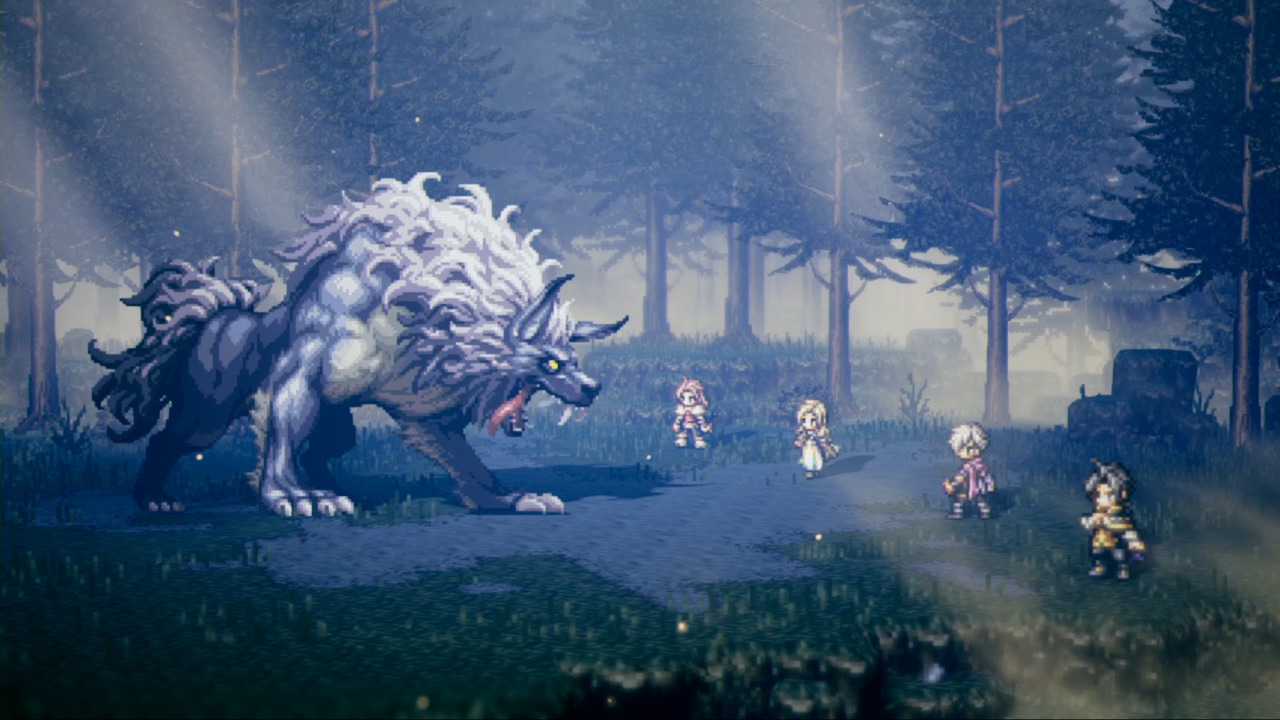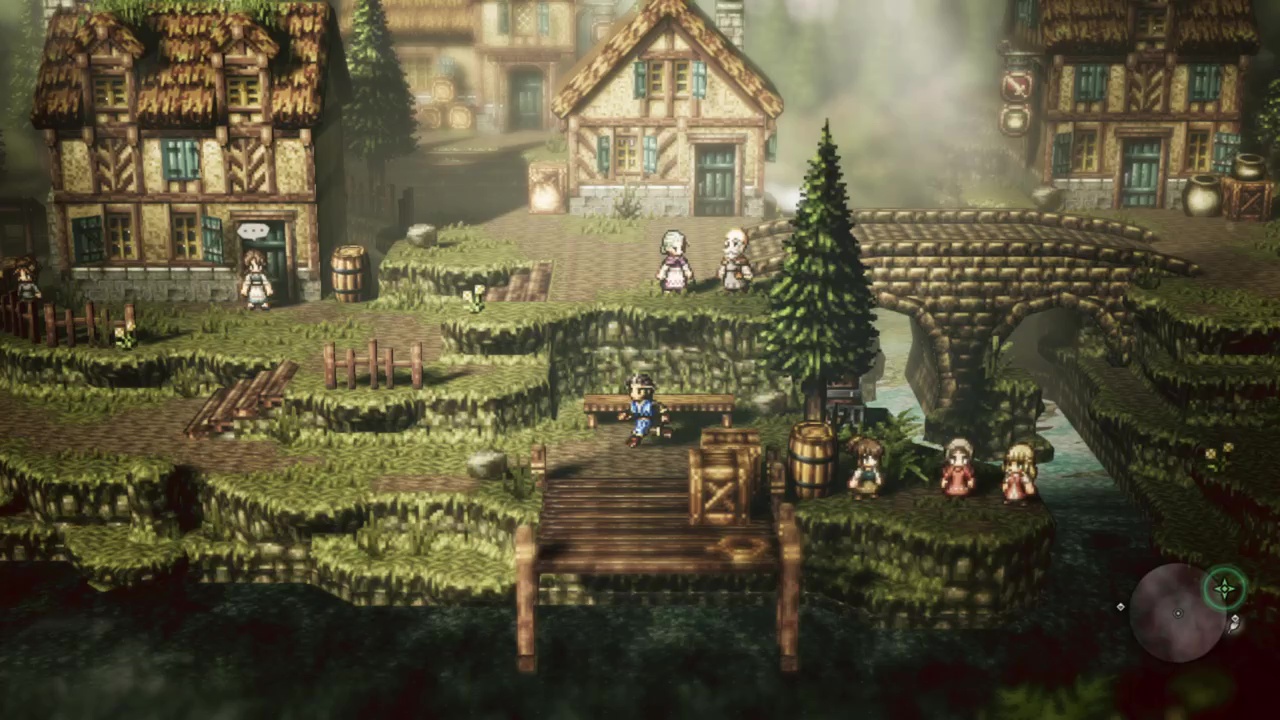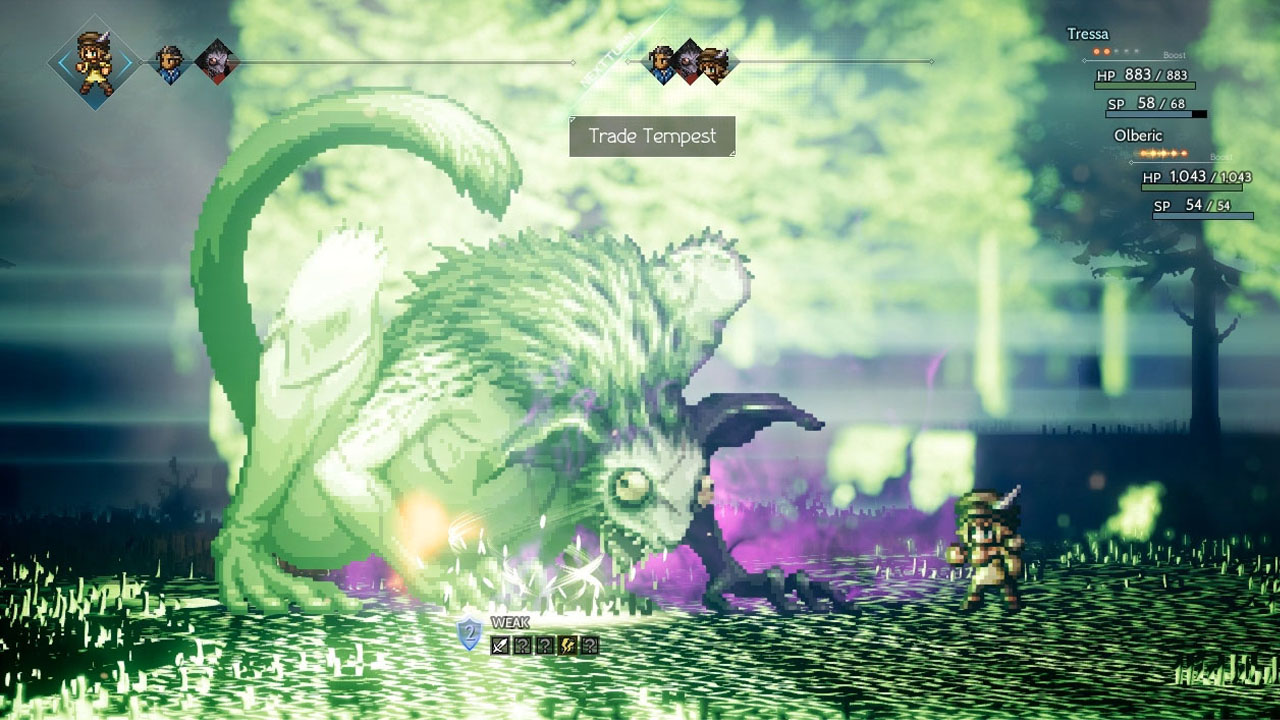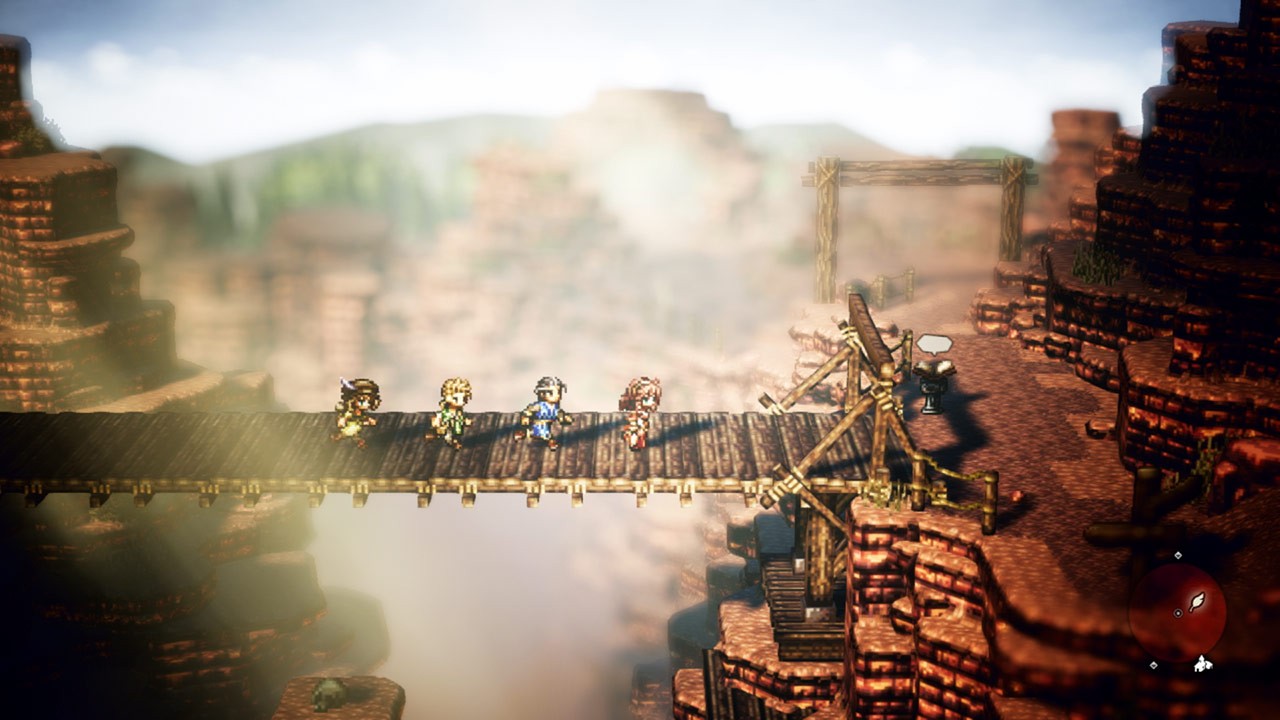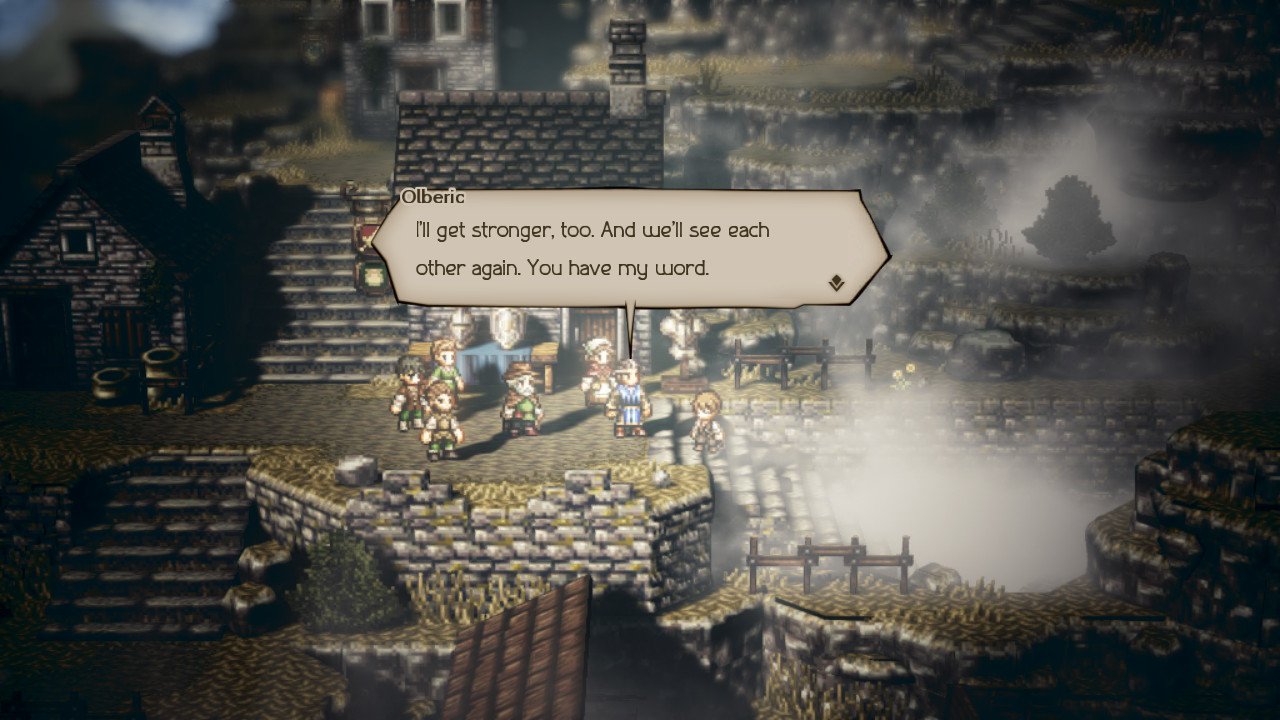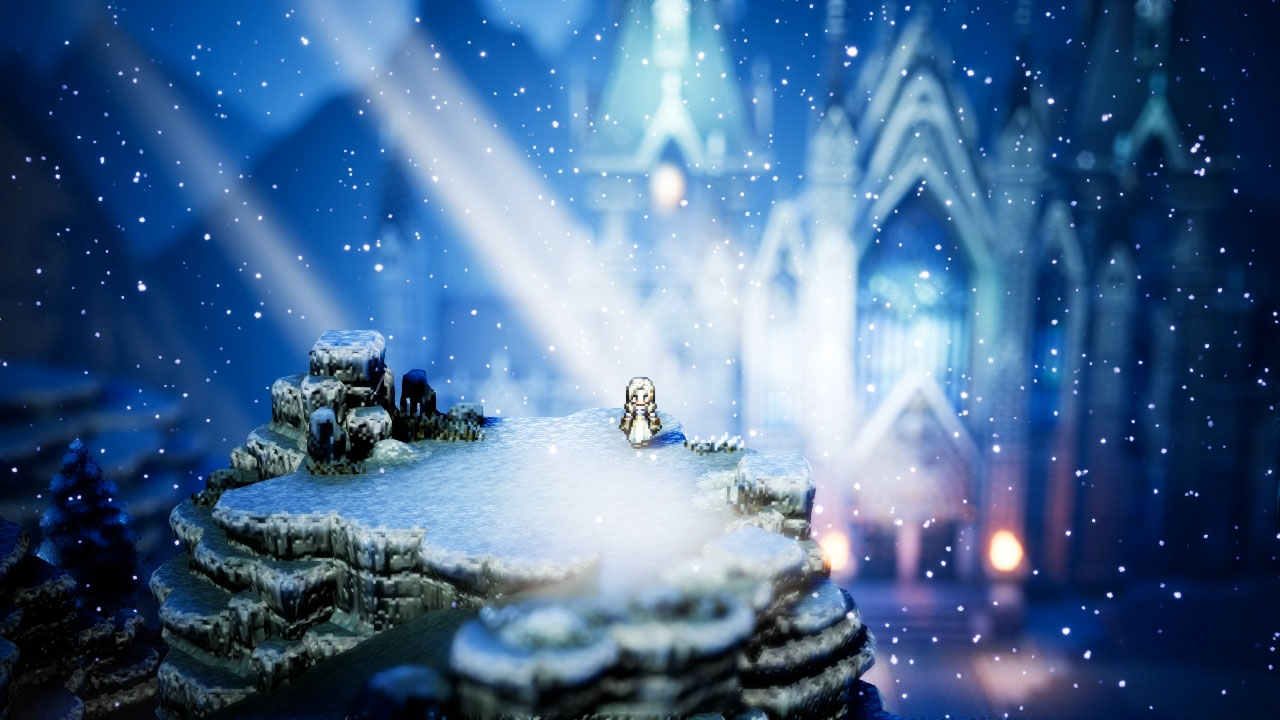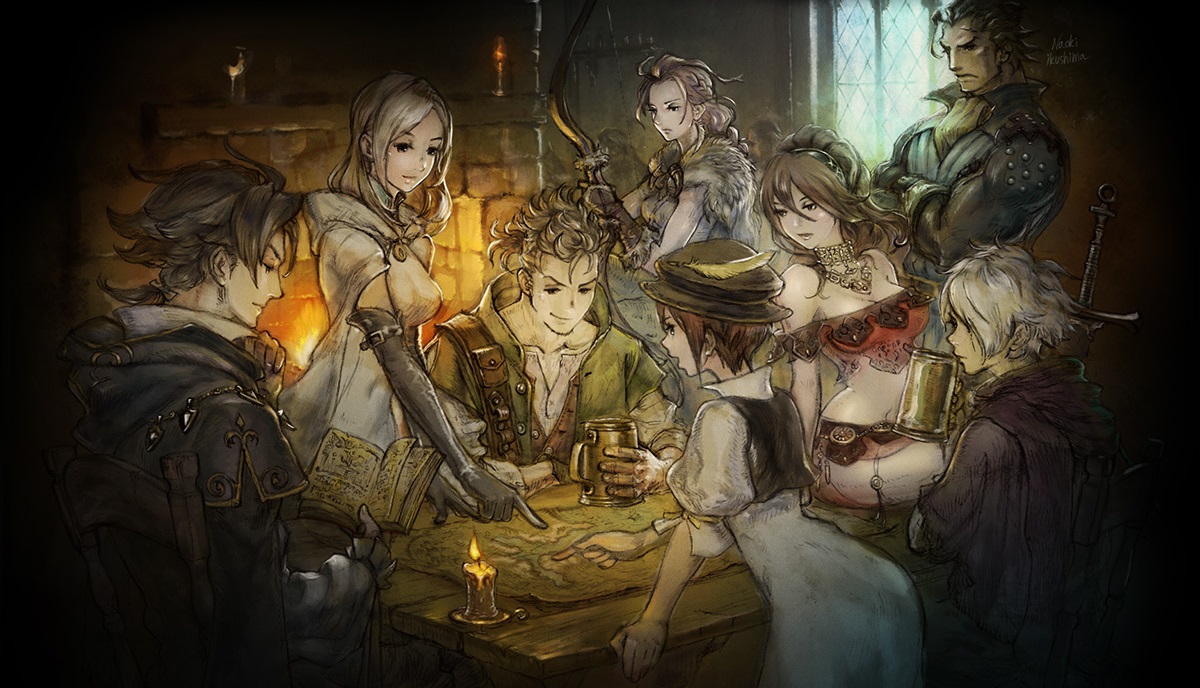While independent developers rake in cash making pixelated rehashes of old 80s and 90s era JRPGs, it seems ironic that the one company whose games these hip developers are emulating are completely unable to do it themselves. God bless them for trying, but Square Enix’s own efforts at creating a “throwback” JRPG have, for the most part, blown up in their face. Whether it was the monotonous and bland gameplay of I Am Setsuna or the botched remake of Secret of Mana, Square Enix’s nearly unlimited funds have not been able to buy them the same kind of success and public reception indie darlings like Stardew Valley and Boot Hill Heroes have garnered.
Octopath Traveler
Publisher: Nintendo
Developer: Square Enix
Platform: Nintendo Switch (Reviewed)
Release Date: July 13th, 2018
Players: 1 Player
Price: $59.99
Aforementioned failed attempts at recapturing golden era JRPG goodness is why when I first heard of Octopath Traveler’s demo last fall, I completely ignored it and shrugged it off as not worth clogging up my backlog with.
Only after continuous urgings from my friends to play it did I finally queue the download on the Switch and give it a fair shot. It was fortunate that I did, since what little the trial allowed me to play convinced me that Square was onto something and could, for once, beat their fans at creating a true Squaresoft style RPG.
At first glance, Octopath Traveler looks like just another nostalgic rip-off game, borrowing the multi-character story seen in the SaGa games and packaging it in a turn-based combat system full of characters that can change classes, a la Dragon Quest 3.
The only feature that didn’t look like it was dragged out of a flannel-coated Clinton-era coma would be the graphics, which immediately drew me in when I first booted it up.
Before I continue, let me state for the record that nostalgia is the ultimate low-hanging fruit in the video gaming hobby. Combining low effort with usually high rewards, the tactic of playing on the fond memories gamers have towards long-dead gameplay styles is a surefire method to make a quick buck without doing much to deserve it.
Though I’m sure many independent developers would recoil at me saying it, I’m willing to bet a fair amount of older gamers like myself agree. As fun as revisiting the past is, most developers seem to forget that there’s a huge difference between simply copying something and being “inspired” by it.
By this, I mean if a game is going to hold my attention beyond the first few hours of play, it will have to do more than dredge up nostalgic feelings of a title I loved 30 years ago. It needs to be less of a copy and more of a tribute. It needs new gameplay systems, innovative additions to its core mechanics, and preferably a graphical style that didn’t come from the RPGmaker default assets pack.
A good example would be the Etrian Odyssey series. While it draws heavily from the dungeon-crawling, Wizardry style gameplay left abandoned in the 80s, it repackages those themes under the greater encompassing framework of a modern RPG with updated visuals and new systems.
Etrian Odyssey accomplishes this with its FOE mechanic and updated hand-drawn art designs, both of which help give the game a wholly modern look and feel, something a good retro game needs if it intends to hold the attention of people who grew up playing the titles it is based off of.
Bad examples are, unfortunately, much easier to find. Horrible rip-offs like the Earthbound-esque “Citizens of Earth” and “Pier Solar”, which plays like it’s Lunar Eternal Blue 2.5, are more along the lines of what you’ll find when you open your Steam new arrivals list tonight…and it’s that sad reality that I had hoped the industry would work to change.
Thankfully, Square Enix has learned their lesson, since Octopath Traveler is everything a nostalgic RPG should be, and then some.
Once I started playing, it became apparent that the developers behind Octopath Traveler not only loved the JRPG genre, but understood what makes it so fun and addicting in the first place. As any true fan will tell you, it’s more than just leveling up and class changes. It’s about exploring diverse landscapes, fast paced progression, tear-inducing storylines, and combat easy enough to be understood without a manual, yet complex enough to hold your attention for 40 hours.
Octopath’s developers must’ve had a long list of every feature they could remember that made them love the JRPGs of their youth and endeavored to include each one without fail, since what they’ve created is nothing less than an invincible Chimera of 1990s JRPG goodness that couldn’t have possibly come from Square Enix’s white shirt stockholders or boardroom managers. No, Octopath is something I would have never expected them to ever push out the door with their name on it; the kind of old-school quality RPG that they stopped making after Final Fantasy IX.
Octopath Traveler, as the name so eloquently implies, is about eight different people who, for varying reasons, leave the safety of their home and seek out a greater adventure, eventually bumping into one of the other seven travelers who are doing the same.
Unlike SaGa Frontier, which forces you to repeat the same dungeons and quests for each of its player characters every time you start a new story, Octopath improves upon the idea of multiple heroes and has them “organically” meet each other at a time governed by the player’s actions.
Essentially, the main hero of the first story you pick can wander the map for days doing whatever you want, but whenever you feel ready to start a new chapter or recruit one of the other seven heroes, all you have to do is head to their location, which is marked on the map, and engage them in conversation.
At that point, you’ll be hit with a prompt asking if you’d like them to join you, and if so, would you like to hear their story? If so, you play through a short vignette detailing their life up until the point you found them in town and then join them on a short quest.
After that initial quest, they become your permanent party member and you can either continue their story, or move on to another. Surprisingly, Octopath is incredibly non-linear and allows the player to move at their own pace, taking in the world as quickly or as slowly as they want.
What’s even more impressive is, that while the game doesn’t advertise this, it is in truth an open-world RPG. Where you go and what you do is completely up to you. The order with which you visit the game’s towns and dungeons are not set in stone, and other than requiring you to complete a party member’s previous chapter before moving onto the next, there is nothing holding you back from free-wheeling your way through the overarching story.
Matter of fact, it’s quite common to encounter dungeons on the paths between towns that are significantly higher level than you. Since the game is entirely “open” and non-linear, there is no scaling and you can – and will – often blunder into areas filled with monsters that one-shot kill you. Granted, a small prompt comes up in the bottom left corner that notifies you of the level you must be for each area, but it’s an easy thing to forget about. At least for me, it was.
This surprising level of openness doesn’t end there, as it also extends to side quests as well. Many of the townspeople will have their own mini-quests to complete, and in nearly every instance, there are multiple ways to address their problems. This is due in large part to the special field skill each party member has access to. These unique abilities, which all have clever uses both in and out of combat, are fun to use and often grant rewards upon their proper usage.
Want to summon monsters in battle? Have the Hunter capture a weakened enemy and call upon it in battle…or command it to fight an ornery yokel who is giving a quest giver trouble. Feel like shopping for rare equipment? Have your merchant class character go up to every citizen you see and barter with them to see what unique items they are willing to part with.
Want to discover the secrets each town hides that you aren’t privy to? Use the Scholar’s inquiry skill and trick the locals into divulging the location of hidden treasure or giving you access to the shopkeeper’s extended inventory. There are plenty of ways to utilize each party member, and discovering how best to fleece the local populace is just part of the fun.
All this non-linearity comes at a heavy price though. As with anything that allows for total end user control, some caveats to storytelling have had to be made. Firstly, the stories for each individual character start awkwardly if you have other people in the party, since they aren’t written open-ended enough to allow for the possibility of the hero having partners.
What this means is you’ll have people constantly making comments that they can’t believe you’re doing something by yourself or that a boss is fighting you one-on-one, when in reality, you have half a dozen well equipped buddies behind you that are 10-15 levels higher than you joining you in your fights.
Also, due to the lack of acknowledgement the NPCs show to the other seven characters, there is a problem with the game’s suspension of disbelief.
There’s a feeling that no matter what is really happening or what the situation is, you have to somehow believe that this guy you are following the story of doesn’t have a bunch of animals and well-trained fighters following him around town 24/7. It results in a lot of missed opportunities for storytelling and means each character isn’t as fully “fleshed-out” as they probably should have or could have been.
Thankfully, as the stories progress, you’ll find that some of the characters have goals that intersect, and that’s when the real game begins. Though to get that point, you’ll have to smash through a good 15-20 hours worth of solo story telling.
Of course, you don’t buy a JRPG to be wowed by a good storyline. You play it for the combat, the grinding, the dungeons, and the tough bosses…and unlike the shaky characterization, Octopath has no problem delivering in those areas.
Each of the eight heroes starts with a pre-defined class that can equip a certain set of weapons and gains access to certain abilities related to their profession. This can be fine tuned a bit further by unlocking the eight classes by finding shrines hidden in the game world.
Once a class is unlocked, you can change one of the heroes to that other class and create a hybrid character out of them. So if you want the Cleric Ophilia to learn some offensive skills, you can change her to a knight class and enjoy having a healer with tanking abilities.
Not to mention there are 4 even more advanced classes hidden behind optional boss fights. There’s also a fair amount of flexibility in the equipment as well, since anyone can wear any armor regardless of class, and the attribute bonuses given by armor varies greatly enough that you can modify a character’s role just by changing the style of armor you use on them.
The lighter an armor, the bigger its bonuses to elemental damage and defense, and the heavier it is, the more defense and physical resistance it possesses. Again, not a revolutionary system by any means, but combined with the dual classing options, it gives you that Dragon Quest style openness in class changing that you a lot of JRPGs nowadays seem to have forgotten.
Combat itself feels very similar to the later Shin Megami Tensei games and their “Press Turn” system, since the rhythm of battle is based around stockpiling bonuses and exploiting an enemy’s weakness to make them vulnerable, then unleashing all your built up turns on them at once.
A wise tactic in Octopath is to leave an enemy one hit away from being “broken” and waiting until they signal their special attack move to hit them with their weakness. When doing this, you knock them temporarily unconscious and get a free round of hits against them with guaranteed criticals. Like I said earlier, this isn’t an overly complex system, but it’s very elegant and easy to grasp.
In between combat and storytelling, there’s exploration, and as I mentioned earlier, the overworld map is very diverse in its locales and is surprisingly large for such a retro-looking game.
With over a dozen major towns and three times as many “dungeons”, as well as a final post-game adventure, don’t expect Octopath to be the short throw-away game like previous throwback outings were. No, Octopath Traveler is loaded with content, and is every bit the gargantuan JRPG you’d expect from Square Enix.
Though the size of the world is impressive, the visual flair with which they’ve rendered it in is even more so. Thanks to the Unreal engine, the game has no problem using its 16bit era pixelated graphics to create a beautiful atmosphere.
Snow twinkles in a series of flashes and slowly dithers in the background as you move closer to the camera, godrays of sunlight breach the tips of castle rooftops, and shadows bend and move around you as you cart your lantern through dark and gloomy caverns. It’s enough to make even a Minecraft-hating, pixel-loathing graphics fanatic like me pause to take a few screenshots.
With great character building options, a simple but fun combat system, and a large open world to explore in relative non-linearity, there’s enough of a reason for both nostalgia seeking gamers and younger, newer players to invest their time in Octopath Traveler. Granted, the heroes should interact more often and their stories should acknowledge what characters you bring into them, but it’s a small quibble that doesn’t detract from the total package.
Octopath Traveler is all about taking the very best facets of every classic JRPG and combining it with newer features such as open world gameplay and non-linearity to create an extremely addicting and well built throwback RPG that fans both young and old will find hard to resist. Most of all, however, is the fact that the game feels like those who developed it truly love the genre and this is their love letter to it and its fans.
There’s nothing like taking your party of 2D sprite based, properly min/max’ed SNES JRPG stereotypes through a large 2.5D Unreal engine powered world and unleashing screen-rocking spells into drooling, swaying, angry looking monsters in turn-based combat. If that’s your idea of a fun time, then you have no reason to skip Octopath Traveler.
Octopath Traveler also serves as a great example of how to make a quality nostalgia-focused game. The key to making such a game is not to literally be that older title, but to instead emulate little bits and pieces of it while working those fragments into something new and modern.
Hopefully both Square Enix and Nintendo realize what they have here and not only make more games like this, but focus on the JRPG genre the way the NES and SNES did. Octopath Traveler shows how wonderful the genre can be when it’s done correctly and on a system whose portability allows it to be played the way a relaxing, comfy JRPG should be.
Octopath Traveler was reviewed using a review copy obtained by Niche Gamer. You can find additional information about Niche Gamer’s review/ethics policy here.
The Verdict: 9.0
The Good:
- Large world with tons of content
- Lots of class/character options
- Simple but addictive combat
- Gorgeous visuals and an outstanding soundtrack
The Bad:
- Missed opportunities for story-telling, short/weak storylines
- Game takes a while to “warm up”, starts slow
